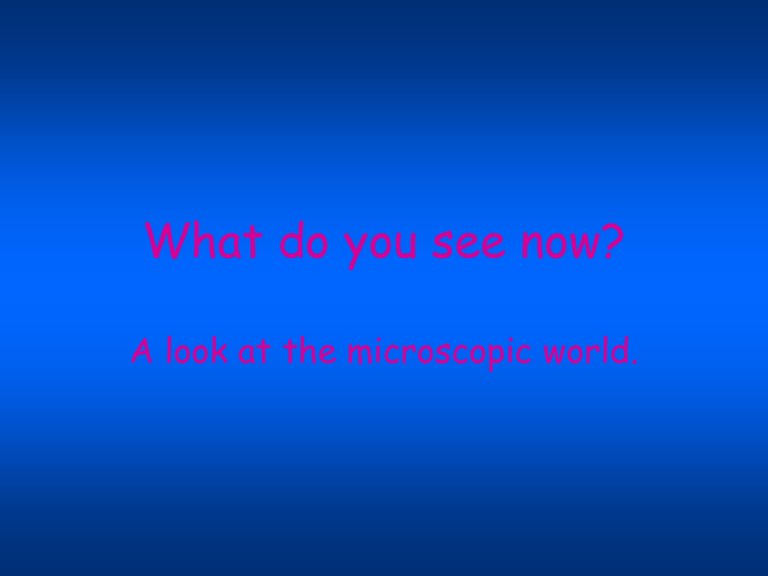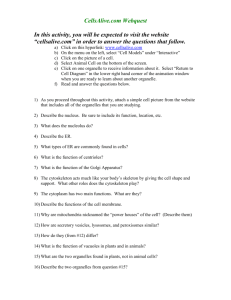What do you see now? - Parkway C-2
advertisement

What do you see now? A look at the microscopic world. What do you already know? • Answer the following five questions then check your answers on the following slide. • 1. Which letter represents where your specimen goes? 2. Which letter represents the course adjustment knob? 3. Which letter represents the part you use to change the magnification? 4. Which letter represents the part you use to get the image in fine focus? 5. Which letter represent the part you look through? • • • • What do you already know? • • • • • • Which letter represents where your specimen goes? (E) Which letter represents the course adjustment knob? (B) Which letter represents the part you use to change the magnification? (D) Which letter represents the part you use to get the image in fine focus? (C) Which letter represent the part you look through? (A) Give yourself one point for each correct answer. How comfortable are you with using microscopes? • I’ve never seen one – 0 pts. • I’ve seen them but never used one – 1 pt. • I’ve used them long ago – 2 pts. • I know how to use them it just isn’t easy – 3 pts. • I love using microscopes and I’m good at it – 5 pts. The Pretest Results Your Score Eight points or more – your ready to move on. Seven or less points lets review a little. Go to the web site http://science.howstuffworks.co m/light-microscope.htm and discover microscopes. Then ask your teacher to get you a real microscope so you can practice. (The picture to the right is the head of mosquito at 200X real size). What can Microscopes see? • There is a lot of things out there that are just to small to see without a little help. The web site http://cellsalive.com/howbig.htm has an animation that will help you understand the relative size of different things. • Proceed to the site (you can click on the above site) then click on “Start the animation”. • Please record the order and the magnification items become visible in your lab book. Now that you’re an Expert on the size of things…. • • • • • • • 1. What’s bigger Baker’s yeast or a Red blood cell? 2. At what magnification did the Red blood cell become visible? 3. What is E. coli’s approximate size? 4. Compare the size of a dust mite to the width of a human hair. 5. Do you think the physical structure of Ragweed pollen contributes to its effectiveness as an allergen? Why or why not? 6. Rhinovirus cause the “common” cold do you think their size has anything to do with their ability to get past the human bodies defense barriers? Why of why not? Place your answers in your answer sheet using complete sentences. Compare your answers! • Find a partner and see if your answers agree. If they do check with another group just to be sure. • If your answers are different see if you can come to an agreement, then check with two other groups to be sure. • If you can’t agree, work with another group to see if you can figure it out, then double check with a third group. • If you’re getting frustrated remember I’m (the teacher) here to help!!! Now that you understand the relative size of some things… • We’re ready to move on to a closer look at cells and their components. • If you have some extra time the following slide has some sites where you can gain additional insights just click on what you want to explore. Have time? Discover More!!! • • • • • For info about the rhinovirus http://www.discovery.com/area/ skinnyon/skinnyon980206/skinn yon.html To learn more about dust mites http://www.cellsalive.com/mite. htm Getting rid of dust mites http://familydoctor.org/683.xm l Is there more ragweed pollen? http://allergies.about.com/cs/ra gweed/a/aa091100a.htm Help for ragweed sufferers. http://www.niehs.nih.gov/airbor ne/prevent/ragweed.html But what’s a cell anyway? • There are two broad groupings of cells – eukaryotes and prokaryotes – we are going to explore them next. Please click on the following web site and we’ll begin. http://cellsalive.com/c ells/3dcell.htm What’s size got to do with it? • In your lab book compare the relative size of the two different types of cells (eukaryotes and prokaryotes). • Also describe the relative complexity of each of the two cell types. Some thoughts to ponder…. • Record your answers to the following questions in your lab book using complete sentences. • 1. Are all cells the same size? • 2. Do all cells have the same stuff? • 3. Which type of cell can be found in your body? Explain. • 4. Give a rational for why eukaryotic cells not only need but have many more internal structures than prokaryotes. Compare your answers! • Find a partner and see if your answers agree. If they do check with another group just to be sure. • If your answers are different see if you can come to an agreement, then check with two other groups to be sure. • If you can’t agree, work with another group to see if you can figure it out, then double check with a third group. • If you’re getting frustrated remember I’m (the teacher) here to help!!! A more in-depth look at eukaryotes • • • • • Plant and animal cells have more in common with each other than either does with bacterial cells. Eukaryotes have internal membranes and structures that are easily identified using electron microscopes. Use the following web site to further explore animal cells. http://cellsalive.com/cells/animcell. htm Hint – if you point at an object its name appears; if you click on an object a description of task it performs appears. Record your findings in your lab book using complete sentences. Check your understanding of animal cells • • • • • • • • 1. What is the power center of the cell? 2. What organelle do animal cells have that plant cells do not contain? 3. What is the control center of the cell? 4. What organelles have a function in protein synthesis and modification and transport? 5. How do cells with the same DNA do different things? 6. Muscle cells need a lot of energy, which organelle would you expect them to have more of than other types of cells? Why? 7. Describe an animal cells distinguishing characteristics. Record your answers in your work sheet using complete sentences. Compare your answers! • Find a partner and see if your answers agree. If they do check with another group just to be sure. • If your answers are different see if you can come to an agreement, then check with two other groups to be sure. • If you can’t agree, work with another group to see if you can figure it out, then double check with a third group. • If you’re getting frustrated remember I’m (the teacher) here to help!!! Let’s look at Plant Cells • Like animal cells plant cells are eukaryotes. • Unlike animal cells plant cells can produce their own food with the help of the sun. • Plant cells have many of the same organelles that animal cells contain but there are some differences. • Click on the following web site to explore plant cells: http://cellsalive.com/cells/plntc ell.htm • Record your findings in your lab book using complete sentences. Plants, what did you learn? • • • • • • 1. What cell parts are exclusive to plant cells? 2. What organelle produces energy for plant cells? Is it the same one that produces energy for animal cells? 3. What does the golgi apparatus do? 4. Why do you think plant cells have such a large vacuole? 5. If plant cells have less lysosomes what do you think would happen? Record your answers in your work sheet using complete sentences. Compare your answers! • Find a partner and see if your answers agree. If they do check with another group just to be sure. • If your answers are different see if you can come to an agreement, then check with two other groups to be sure. • If you can’t agree, work with another group to see if you can figure it out, then double check with a third group. • If you’re getting frustrated remember I’m (the teacher) here to help!!! Prokaryotes, the oldest cell. • Before there were plants and animals prokaryotes ruled the world. • While they are normally much smaller in size they have much in common with eukaryotic cells in that they must stay alive. • Please go to the following web site and explore the world of bacteria: http://cellsalive.com/cells/bactc ell.htm Prokaryotes, the oldest cell. • 1. What parts do bacteria, plants and animal cells have in common. • 2. What function does the capsule fulfill? • 3. What is more permeable, the cell wall or the cell membrane? • 4. Besides DNA/RNA what internal structure does bacteria share with plant and animal cells? • 5. What is found in the nucleoid? • Record your answers in your work sheet using complete sentences. Compare your answers! • Find a partner and see if your answers agree. If they do check with another group just to be sure. • If your answers are different see if you can come to an agreement, then check with two other groups to be sure. • If you can’t agree, work with another group to see if you can figure it out, then double check with a third group. • If you’re getting frustrated remember I’m (the teacher) here to help!!! Now that your are an expert! • It wasn’t that long ago that the world of microscopic life was thought of in a magical manner. Now that you know better please create a Venn diagram to compare and contrast plant, animal, and bacterial cells. You will need 3 overlapping circles. One circle is animal, one plant, and the last bacteria. Include all of the organelles presented in your previous studies. A B C Still got time???? (If you’ve finished all the required work here’s something more you’ll find valuable. • How do we get more cells? Why do we need more cells? Both are great questions. Click on http://cellsalive.com/m itosis.htm to find out. Record your data in your lab book using complete sentences. The Last Step of the Process…teach the teacher!!! • Develop a 4 slide “PowerPoint” presentation you will present to the class. – 1 What’s the difference between prokaryotes and eukaryotes? – 2 How are plant and animal cells alike? – 3 What did you learn about the relative size of things? – 4 How do organelles help keep larger cells alive? References How stuff works (2005). Retrieved from http://science.howstuffworks.com/light-microscope.htm Cells Alive (2005). Retrieved from http://cellsalive.com/howbig.htm Discovery (2005). Retrieved from http://www.discovery.com/area/skinnyon/skinnyon980206/skinnyon.html Cells Alive (2005). Retrieved from http://www.cellsalive.com/mite.htm Family Doctor (2005). Retrieved from http://familydoctor.org/683.xml About (2005). Retrieved from http://allergies.about.com/cs/ragweed/a/aa091100a.htm NIH (2005). Retrieved from http://www.niehs.nih.gov/airborne/prevent/ragweed.html Cells Alive (2005). Retrieved from http://cellsalive.com/cells/3dcell.htm Cells Alive (2005). Retrieved from http://cellsalive.com/cells/animcell.htm Cells Alive (2005). Retrieved from http://cellsalive.com/cells/plntcell.htm Cells Alive (2005). Retrieved from http://cellsalive.com/cells/bactcell.htm Cells Alive (2005). Retrieved from http://cellsalive.com/mitosis.htm



